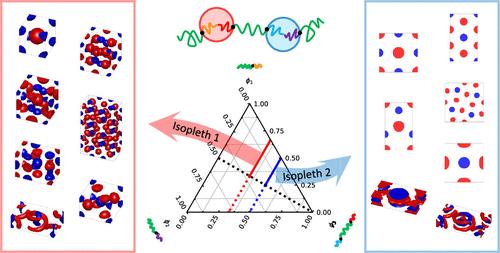Binary Macromolecular Mesocrystals via Designed Block Copolymer Blends
IF 5.2
1区 化学
Q1 POLYMER SCIENCE
引用次数: 0
Abstract
The theoretical prediction that various binary macromolecular mesocrystals composed of A and C spheres could be formed by B1AB2CB3 pentablock terpolymers ( JACS 2014, 136, 2974–2977) offers a promising route to fabricate these intricately structured nanomaterials. However, experimental realization of this strategy has been impeded by the requirement of synthesizing precisely designed pentablock terpolymers. Here, we propose a conceptually new and technically simpler route to engineer binary macromolecular mesocrystals by using BA′/ABC/C′B ternary block copolymer blends that are designed to replicate the phase behavior of B1AB2CB3 pentablock terpolymers. Using self-consistent field theory, we show that the ternary blends exhibit similar self-assembly behaviors as the pentablock copolymers, forming various mesocrystals with controllable coordination numbers. This study offers a simpler alternative to fabricating novel macromolecular mesocrystals and introduces a general design principle for emulating multiblock copolymers by block copolymer blends.

通过设计嵌段共聚物共混制备二元大分子介晶
理论预测B1AB2CB3五嵌段三元聚合物可以形成由A和C球组成的各种二元大分子介晶(JACS 2014, 136, 2974-2977),为制造这些复杂结构的纳米材料提供了一条有希望的途径。然而,该策略的实验实现一直受到合成精确设计的五嵌段三元聚合物的要求的阻碍。在这里,我们提出了一种概念上新的和技术上更简单的途径,通过使用BA ' /ABC/C ' b三元嵌段共聚物共混物来设计二元大分子介晶,该共混物旨在复制B1AB2CB3五嵌段三元共聚物的相行为。利用自洽场理论,我们发现三元共混物表现出与五嵌段共聚物相似的自组装行为,形成各种配位数可控的介晶。本研究为制备新型大分子介晶提供了一种更简单的方法,并介绍了用嵌段共聚物共混物模拟多嵌段共聚物的一般设计原则。
本文章由计算机程序翻译,如有差异,请以英文原文为准。
求助全文
约1分钟内获得全文
求助全文
来源期刊

Macromolecules
工程技术-高分子科学
CiteScore
9.30
自引率
16.40%
发文量
942
审稿时长
2 months
期刊介绍:
Macromolecules publishes original, fundamental, and impactful research on all aspects of polymer science. Topics of interest include synthesis (e.g., controlled polymerizations, polymerization catalysis, post polymerization modification, new monomer structures and polymer architectures, and polymerization mechanisms/kinetics analysis); phase behavior, thermodynamics, dynamic, and ordering/disordering phenomena (e.g., self-assembly, gelation, crystallization, solution/melt/solid-state characteristics); structure and properties (e.g., mechanical and rheological properties, surface/interfacial characteristics, electronic and transport properties); new state of the art characterization (e.g., spectroscopy, scattering, microscopy, rheology), simulation (e.g., Monte Carlo, molecular dynamics, multi-scale/coarse-grained modeling), and theoretical methods. Renewable/sustainable polymers, polymer networks, responsive polymers, electro-, magneto- and opto-active macromolecules, inorganic polymers, charge-transporting polymers (ion-containing, semiconducting, and conducting), nanostructured polymers, and polymer composites are also of interest. Typical papers published in Macromolecules showcase important and innovative concepts, experimental methods/observations, and theoretical/computational approaches that demonstrate a fundamental advance in the understanding of polymers.
 求助内容:
求助内容: 应助结果提醒方式:
应助结果提醒方式:


